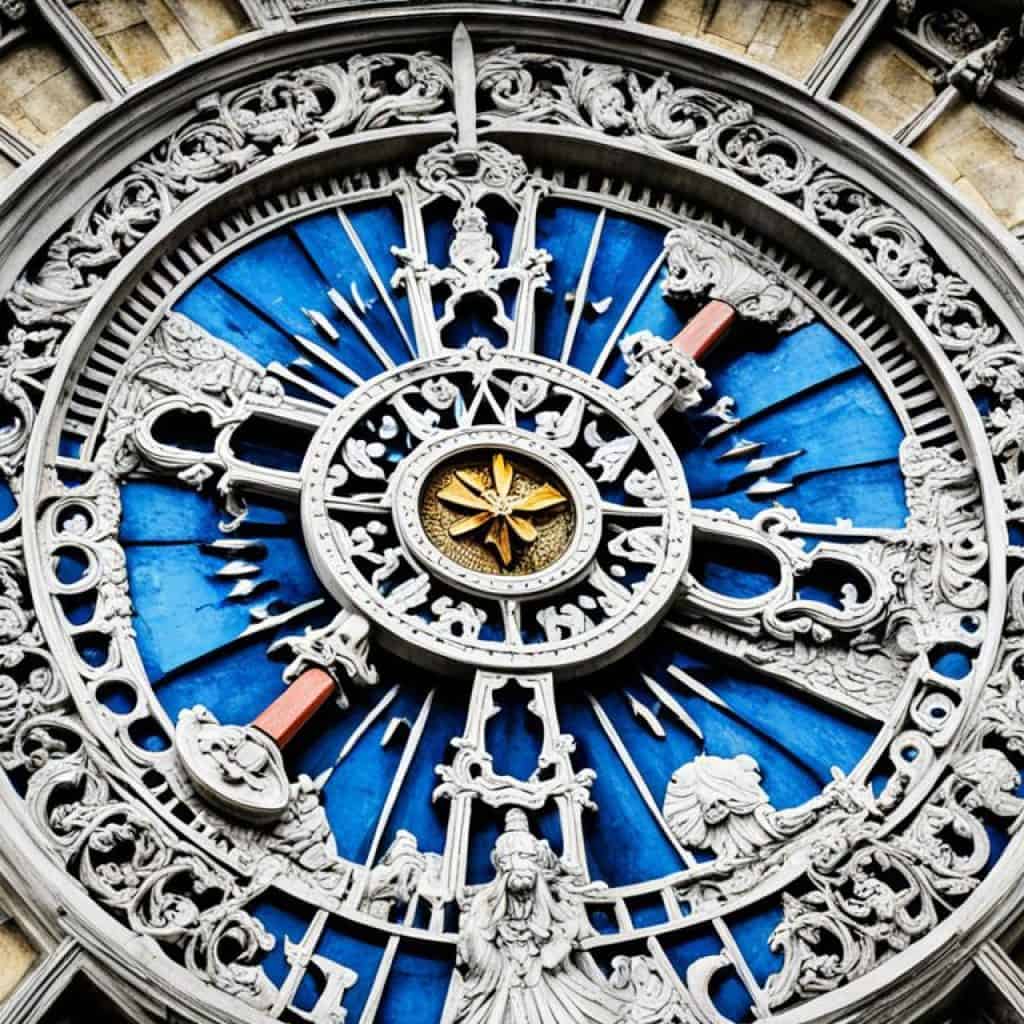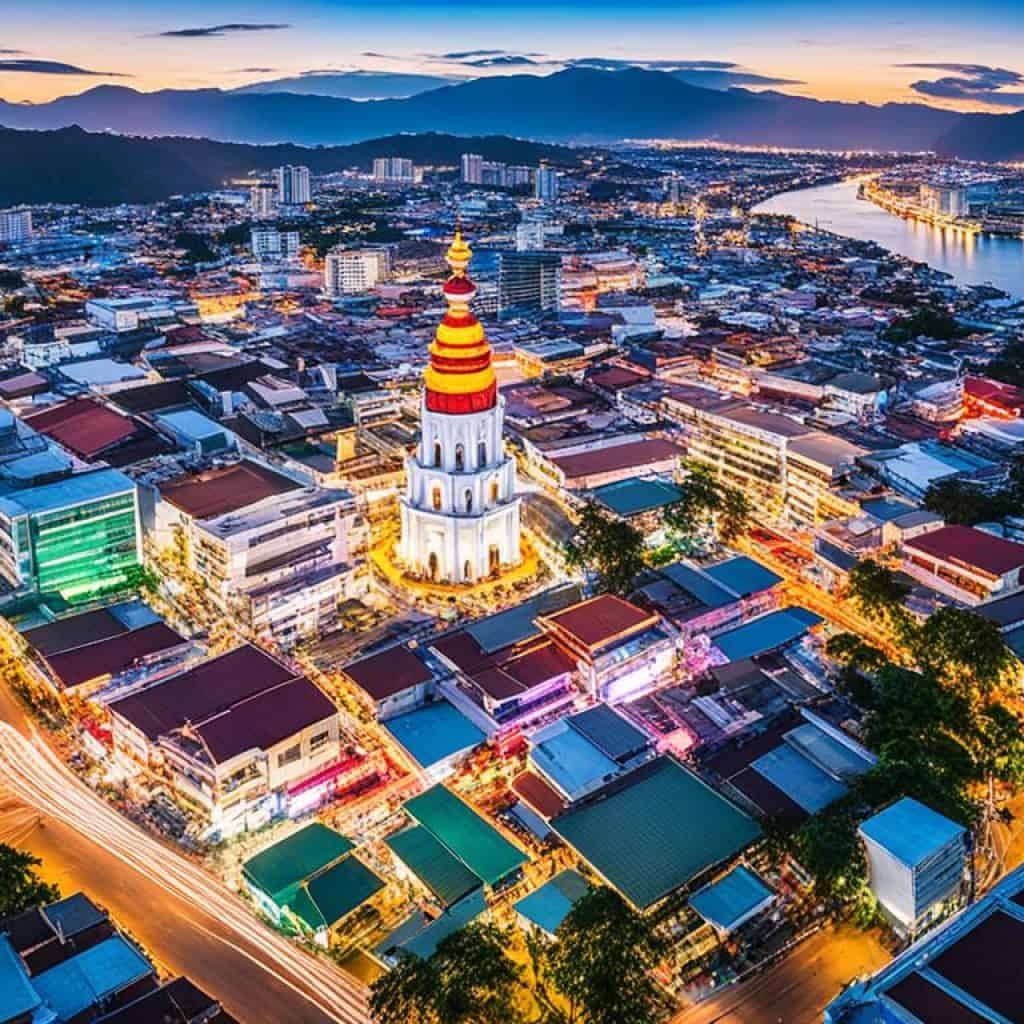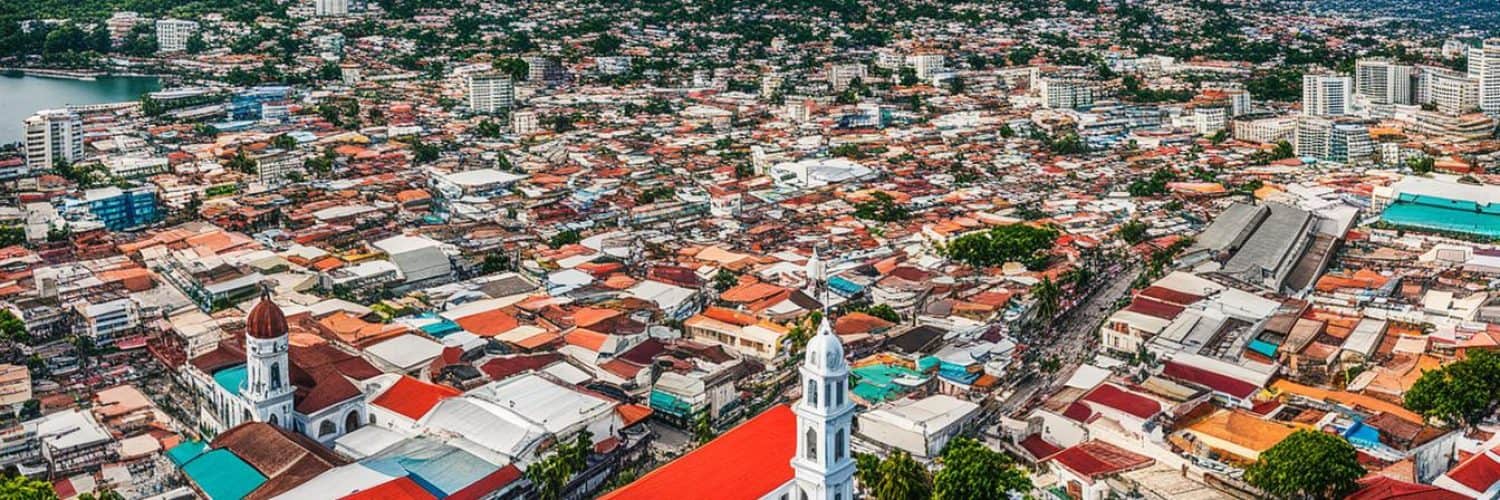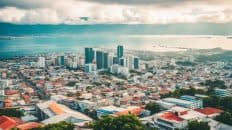Did you know that Cebu City, the oldest city in the Philippines, holds a treasure trove of history that spans ancient civilizations and colonial influences? Embark on a fascinating journey through time as we dive into the historical background of Cebu City and uncover its significance as a cultural and historical hub.
From the remnants of ancient civilizations to the enduring marks left by the Spanish colonial era, Cebu City has witnessed the ebb and flow of time, shaping its vibrant tapestry of past and present. Let’s uncover the stories behind its historical landmarks, discover its rich cultural heritage, and delve into the evolution of this remarkable city.
Key Takeaways:
- Cebu City, the oldest city in the Philippines, boasts a rich history that spans ancient civilizations and colonial influences.
- The city is home to significant historical landmarks that stand as testaments to its diverse past.
- Cebu City’s cultural heritage is rooted in the influence of early settlers and is evident in archaeological sites and artifacts found in the area.
- The Spanish colonial era played a major role in shaping Cebu City’s history, leaving behind notable landmarks and monuments.
- Over the years, Cebu City has evolved from a small settlement to a bustling metropolis, showcasing its resilience and growth.
The Ancient Civilization of Cebu City
Nestled in the heart of the Philippines, Cebu City boasts a rich history that dates back to ancient times. Before the Spanish arrived in the 16th century, the city was already home to a vibrant civilization that left its mark on the region. The cultural heritage of Cebu City is deeply rooted in the customs, traditions, and artifacts of these early settlers.
Archaeological sites and discoveries have provided valuable insights into the ancient civilization that thrived in Cebu City. These artifacts, ranging from pottery to tools, offer a glimpse into the daily lives and practices of the early inhabitants. They serve as a testament to the ingenuity and cultural richness of the ancient civilization that once flourished in this area.
“The ancient civilization of Cebu City holds a significant place in the historical narrative of the Philippines. It is a testament to the enduring legacy and cultural heritage of the region.”
Cebu City’s ancient civilization shaped the course of history, influencing subsequent civilizations and laying the foundation for the cultural melting pot that exists today. The locals take great pride in preserving and celebrating the traditions and customs that originated from this ancient past.
Preserving Cultural Heritage
The cultural heritage of Cebu City is carefully preserved through various initiatives and institutions. Museums, such as the Cebu Provincial Museum, exhibit artifacts and provide educational resources for visitors to learn about the ancient civilization. These efforts ensure that the legacy of the ancient civilization remains alive and accessible to future generations.
Moreover, cultural festivals, such as the Sinulog Festival, showcase the centuries-old traditions and practices that can be traced back to the ancient civilization. The Sinulog Festival is a vivid celebration of Cebu City’s cultural heritage, uniting locals and tourists in a vibrant display of music, dance, and religious devotion.
Uncovering the Past
Archaeological excavations and ongoing research continue to unveil new discoveries about the ancient civilization of Cebu City. These investigations shed light on the complex social structures, economic activities, and religious beliefs of the early settlers. Each discovery brings us closer to understanding the profound influence and significance of this ancient civilization in the history of the Philippines.
Exploring the ancient civilization of Cebu City offers a captivating journey into the past. It allows us to appreciate the rich cultural heritage that continues to thrive in the present. As we delve deeper into the history of this ancient civilization, we gain a greater appreciation for the enduring legacy that shapes Cebu City’s identity.
The Spanish Colonial Era in Cebu City
The Spanish colonial era left an indelible mark on the history of Cebu City, shaping its cultural heritage and architectural landscape. The arrival of Ferdinand Magellan in 1521 marked the beginning of Spanish influence in the region, and the subsequent colonization played a pivotal role in the city’s development.
During this period, Cebu City witnessed the construction of several historical landmarks that stand as enduring symbols of its colonial history. One of the most iconic landmarks is Magellan’s Cross, a significant religious symbol and a reminder of the introduction of Christianity to the Philippines. This wooden cross, housed in a chapel near the Basilica del Santo Niño, is believed to have been planted by Magellan himself upon his arrival in Cebu.
“The Spanish colonial era in Cebu City forged the foundations of the city’s distinctive cultural identity. The legacy of this period is reflected in the historical landmarks that provide a glimpse into the city’s rich heritage.”
Another prominent historical site is Fort San Pedro, strategically built to defend against pirate attacks. This Spanish colonial fort, constructed in the 16th century, served as a stronghold and later played a significant role during the Cebuano revolution against the Spaniards. Today, Fort San Pedro stands as a peaceful walled garden, surrounded by lush greenery, with decaying ruins and a small museum showcasing Spanish artifacts.
Exploring these colonial landmarks allows visitors to delve into the city’s past and witness firsthand the architectural grandeur and historical significance of Cebu City’s Spanish colonial era. The blend of indigenous and European influences depicted in these landmarks reflects the cultural fusion that defines the city’s unique character.
Colonial Landmarks in Cebu City
| Landmark | Description |
|---|---|
| Magellan’s Cross | A religious symbol marking the arrival of Christianity in the Philippines. |
| Fort San Pedro | A Spanish colonial fort built to defend against pirate attacks and later used as a stronghold during the Cebuano revolution. |
The Spanish colonial era in Cebu City not only left a lasting architectural legacy but also influenced the cultural fabric of the city. The fusion of indigenous traditions and Spanish customs created a vibrant and diverse cultural tapestry that continues to shape the city’s identity today. From the colonial landmarks to the unique traditions passed down through generations, Cebu City’s rich colonial history remains an integral part of its heritage.
The Evolution of Cebu City
Over the years, Cebu City has undergone a remarkable transformation, evolving from a small settlement into a thriving metropolis. This evolution can be traced through the city’s historical timeline, which depicts the various stages of development and growth that have shaped Cebu City into the vibrant urban center it is today.
Beginning as a humble trading post for the ancient Visayan peoples, Cebu City experienced its first growth spurt during the pre-Spanish era. The settlement became a hub for commerce and cultural exchange, attracting traders from neighboring islands and establishing itself as a regional power.
“Cebu City’s evolution is a testament to the resilience and adaptability of its people.”
The arrival of the Spanish in the 16th century marked a significant turning point in the city’s history. With the establishment of Spanish colonial rule, Cebu City witnessed the construction of monumental structures, such as churches and fortifications, that exemplified the dominant European influence.
Fast forward to the 20th century, and Cebu City experienced rapid industrialization and urbanization as the Philippines underwent modernization. This period saw the rise of skyscrapers, infrastructure development, and the emergence of Cebu City as a key economic center in the country.
Today, Cebu City stands as a vibrant metropolis, blending its rich historical heritage with modern cosmopolitan living. Its bustling streets, diverse cultural scene, and thriving economy attract tourists and residents alike, making it a premier destination in the Philippines.
Cebu City Historical Timeline:
| Period | Key Events |
|---|---|
| Ancient Times | Settlement of ancient Visayan peoples; emergence of trade networks |
| Pre-Spanish Era | Growth of Cebu City as a regional power; flourishing of commerce and culture |
| Spanish Colonial Era | Arrival of Spanish forces; construction of churches and fortifications |
| 20th Century | Rapid industrialization and urbanization; modernization of Cebu City |
| Present Day | Cebu City as a thriving metropolis; fusion of history and modernity |
The evolution of Cebu City showcases the remarkable resilience and adaptability of its people, who have embraced change while preserving their cultural heritage. As Cebu City continues to progress, it remains deeply connected to its historical roots, creating a dynamic cityscape that seamlessly blends the old and the new.
Heritage of Cebu Monument
The Heritage of Cebu Monument stands as a remarkable testament to the historical significance of Cebu City. It is a must-see attraction for visitors seeking to immerse themselves in the rich heritage and stories that have shaped the city’s identity.
This massive structure, located in the heart of Cebu City, offers a comprehensive overview of the city’s history. Through intricately designed sculptures and intricate details, the monument tells the story of Cebu’s past, highlighting significant events and influential figures that have left an indelible mark on its cultural heritage.
The Heritage of Cebu Monument serves as a visual narrative, chronicling the city’s journey from its pre-Spanish era to the present day. It captures the essence of Cebu’s diverse historical influences, including its indigenous roots, the arrival of the Spanish colonizers, and the subsequent waves of change that followed.
As you explore the monument, you’ll discover the magnificently crafted re
Sandiego-Yap Ancestral House
The Sandiego-Yap Ancestral House is a remarkable testament to the rich history of Cebu City. Constructed in the 1600s by a prominent Chinese merchant family, it stands as one of the oldest houses in the Philippines. This well-preserved structure provides a fascinating glimpse into the lifestyle and traditions of the people during that time.
The Sandiego-Yap Ancestral House showcases a unique blend of Chinese, Filipino, and Spanish architectural influences. Marvel at the intricate details of its wooden walls, high ceilings, and beautiful courtyard. Step inside and immerse yourself in the historical ambiance, surrounded by antique furniture, porcelain, and ancestral portraits.
As you explore the different rooms, each holding stories from the past, you’ll gain insight into the daily lives and traditions of the Sandiego and Yap families. From the ancestral altar and religious relics to the traditional clothing on display, every corner of this ancestral house is a treasure trove of historical significance.
Preserving the Past
The Sandiego-Yap Ancestral House stands as a testament to the importance of preserving our cultural heritage. Its preservation allows us to connect with the past and gain a deeper understanding of our history.
Today, the Sandiego-Yap Ancestral House serves not only as a historical landmark but also as a museum that transports visitors back in time. It offers guided tours that provide valuable insights into the historical context of Cebu City and its influential families.
Visiting the Sandiego-Yap Ancestral House
Visiting the Sandiego-Yap Ancestral House is like stepping into a time machine. Take a journey through history and experience the charm of Cebu City’s rich cultural heritage.
The Sandiego-Yap Ancestral House is located in Parian, Cebu City, making it easily accessible for both locals and tourists. A visit to this historical gem is a must-include in any itinerary for those looking to delve deeper into the history of Cebu City.
Affirming Cebu City’s Historical Legacy
The Sandiego-Yap Ancestral House is more than just a structure; it is a living testament to the enduring historical legacy of Cebu City.
By preserving and showcasing houses like the Sandiego-Yap Ancestral House, Cebu City continues to honor and celebrate its vibrant history. These historical houses become windows into the past, connecting us to the stories, traditions, and heritage of our ancestors.
| Key Highlights of the Sandiego-Yap Ancestral House |
|---|
| Constructed in the 1600s by a Chinese merchant family |
| Provides a glimpse into the history and lifestyle of the people during that time |
| Blends Chinese, Filipino, and Spanish architectural influences |
| Well-preserved structure with intricately designed wooden walls and high ceilings |
| Museum showcasing antique furniture, porcelain, and ancestral portraits |
Fort San Pedro
In the heart of Cebu City stands an architectural marvel that bears witness to the Spanish colonial era – Fort San Pedro. Built in the 1500s, this formidable stronghold served as a vital defense against pirates and marauders. Its strategic location allowed it to protect the city’s shores from any encroaching threats.
Fort San Pedro played a significant role in the history of Cebu City, standing as a symbol of resilience and strength. As the centuries passed, the fort transformed from a battleground into a peaceful walled garden, preserving the remnants of its glorious past.
Today, visitors to Fort San Pedro can wander through the decaying ruins, exploring the intricate architecture and imagining the tales of bravery that once unfolded within these walls. The lush greenery and serene atmosphere make it an ideal spot for contemplation and reflection.
“Fort San Pedro is a testament to the rich heritage of Cebu City and the resilience of its people. It stands as a living reminder of our history, inviting visitors to step back in time and immerse themselves in the stories of our ancestors.”
Within the fort, a small museum awaits, offering a glimpse into the Spanish colonial era. The museum houses an impressive collection of Spanish artifacts, including weaponry, pottery, and religious relics. Each item tells a story, shedding light on the cultural exchange and influence that shaped the city.
Fort San Pedro: Quick Facts
| Location | Date Built | Architectural Style | Current Status |
|---|---|---|---|
| Cebu City | 16th century | Spanish colonial | Preserved as a historical landmark |
A visit to Fort San Pedro is a journey through time, immersing oneself in the rich history of Cebu City. It is a testament to the enduring spirit of the Filipino people and a cherished piece of the city’s heritage.
Magellan’s Cross
In the heart of Cebu City stands a historic landmark that carries deep cultural and religious significance – Magellan’s Cross. This iconic structure commemorates the arrival of Christianity in the Philippines and serves as a testament to the country’s rich religious heritage.

Magellan’s Cross is named after Ferdinand Magellan, the Portuguese explorer who led the first circumnavigation of the world. In 1521, Magellan and his crew arrived in the Philippines and introduced Christianity to the indigenous population. The cross that stands today is a replica of the original, which is believed to have been planted by Magellan himself.
The significance of Magellan’s Cross extends beyond its historical value. For Filipinos, it symbolizes the enduring faith and resilience of the nation. It serves as a reminder of the long-standing influence of Christianity in the Philippines and the profound impact it has had on the lives of the people.
“Magellan’s Cross is a symbol of our nation’s enduring faith and the beginnings of Christianity in the Philippines.”
Visitors to Magellan’s Cross can admire its intricate design and appreciate the architectural beauty of the surrounding area. Located near the Basilica Minore del Santo Niño, the cross attracts both tourists and locals who come to offer prayers and pay their respects.
Whether you are a history enthusiast, a religious pilgrim, or simply curious about Cebu City’s cultural heritage, a visit to Magellan’s Cross is a must. It provides a glimpse into the early days of Christianity in the Philippines and offers a moment of reflection on the country’s profound religious roots.
The Replica Cross
The replica cross that stands at Magellan’s Cross is made of tindalo wood and encased in a protective structure to preserve its historical significance. Despite being a replica, the cross holds immense value in the hearts of Filipinos and serves as a tangible reminder of their faith.
Basilica del Santo Niño
The Basilica del Santo Niño, located in Cebu City, holds a special place in the hearts of the Filipino people. It is not only the oldest church in the Philippines but also a symbol of their deep-rooted faith. The basilica houses the Santo Niño de Cebu, a religious relic brought by Ferdinand Magellan himself.
“The Basilica del Santo Niño stands as a testament to the enduring devotion of the Filipino people,” says Father Juan Dela Cruz, a historian at the basilica. “For centuries, pilgrims from all over the country have sought solace and spiritual inspiration within these sacred walls.”
The basilica’s history dates back to the 16th century when the Spanish explorers arrived in the Philippines. It was originally built as a chapel on the spot where the Santo Niño image was found by Spanish soldiers in 1565, after it was lost and rediscovered years later.
Designed in the Spanish colonial style, the Basilica del Santo Niño features intricate architectural details and beautiful stained glass windows. The vibrant colors and ornate decorations create an atmosphere of reverence and awe.
Every year, millions of devotees and tourists flock to the basilica, especially during the Sinulog Festival, a grand celebration dedicated to Santo Niño. This festival is known for its lively street parades, colorful costumes, and religious processions, attracting visitors from all over the world.
To fully experience the spiritual significance of the Basilica del Santo Niño, visitors are invited to attend a Mass or join in the prayers and rituals offered by the church. The solemnity and peacefulness of the basilica provide a sanctuary for reflection, offering solace to those seeking a moment of serenity and connection with their faith.
Devotion to Santo Niño:
The devotion to Santo Niño de Cebu is deeply ingrained in the Filipino culture. The image of the child Jesus represents the triumph of Christianity and symbolizes hope, love, and protection. Each year, millions of pilgrims visit the Basilica del Santo Niño to pay their respects and seek blessings.
- Pilgrims offer prayers and light candles to Santo Niño, seeking guidance, healing, and miracles.
- Devotees believe that Santo Niño has the power to grant their wishes and protect them from harm.
- Special fiestas and processions are held in honor of Santo Niño, combining religious devotion with colorful celebrations.
The Basilica del Santo Niño stands as a remarkable testament to the enduring faith of the Filipino people, attracting pilgrims and tourists alike who are captivated by its historical significance and spiritual presence.
Cebu City’s Vibrant Culture and Cuisine
Cebu City is a melting pot of diverse cultures, with a rich heritage that is celebrated through its vibrant customs, traditions, and mouthwatering cuisine. The city’s unique blend of influences from its ancient civilizations and colonial past has shaped a distinct culture that captivates both locals and visitors alike.
One of the highlights of Cebu City’s cultural identity is its delectable cuisine. The city is renowned for its culinary prowess, offering a wide array of flavors and dishes that will satisfy even the most discerning palate. At the heart of Cebuano cuisine is the world-famous dish, lechon, a whole roasted pig that is crispy on the outside and tender on the inside.
“The succulent taste of lechon is a true gastronomic delight. The crispy skin and juicy meat make it a favorite centerpiece for special occasions and festivities in Cebu City.”
Apart from lechon, Cebu City offers a wide variety of dishes that showcase the richness of its culinary heritage. From savory seafood delicacies like grilled squid and fish sinigang to mouthwatering street food like tuslob-buwa (pork brain stew) and ngohiong (deep-fried spring rolls), there is something to satisfy every food lover’s cravings.
Culinary Influences
Cebu City’s cuisine is a fusion of various influences, reflecting the city’s history as a trading hub in the Philippines. Chinese, Spanish, and Filipino culinary traditions come together to create a dynamic and flavorful food scene. The Chinese community has played a significant role in shaping Cebuano cuisine, evident in dishes like steamed siopao (buns), pancit (noodles), and dim sum.
The Spanish colonial era also left a lasting impact on Cebu City’s food culture, with dishes like paella, chorizo, and empanada still enjoyed today. The blending of these diverse influences has resulted in a unique culinary experience that is a true reflection of Cebu City’s cultural fabric.
Exploring Cebu City’s Culture
Beyond its delectable cuisine, Cebu City is a treasure trove of cultural experiences. From vibrant festivals like Sinulog, which celebrates the city’s patron saint, to traditional arts and crafts like basket weaving and pottery making, there is no shortage of opportunities to immerse yourself in Cebu City’s vibrant culture.
A visit to the Museo Sugbo, housed in a former provincial jail, provides a glimpse into the city’s rich history and culture through its exhibits and artifacts. The Cebu Taoist Temple, with its intricate architecture and serene atmosphere, offers a spiritual retreat where visitors can learn about the Taoist beliefs and traditions practiced by the local Chinese community.
A Taste of Cebu City’s Culture
To truly appreciate Cebu City’s culture, dining at local eateries and food markets is a must. The Sugbo Mercado, a weekend food market, showcases a wide variety of Cebuano and international cuisines, allowing visitors to sample different flavors in one vibrant setting. The Larsian BBQ, a popular open-air food court, offers a unique dining experience where you can grill your own meat and enjoy it with a side of puso (hanging rice).
| Cebu City Custom | Meaning |
|---|---|
| Sinulog Festival | A celebration in honor of the Santo Niño, with grand street parades, colorful costumes, and traditional dances. |
| Ukay-Ukay Shopping | Thrift shopping in local markets, offering a treasure trove of pre-loved clothes, shoes, and accessories. |
| Bahay Kubo | A traditional Filipino house made of indigenous materials, showcasing the simplicity and ingenuity of Filipino architecture. |
Cebu City’s vibrant culture and cuisine are testaments to the city’s rich history and diverse traditions. Whether you’re exploring ancient landmarks or savoring the flavors of Cebuano dishes, the city offers a truly immersive cultural experience that will leave a lasting impression.
Cebu City’s Nightlife and Entertainment Scene
When the sun goes down, Cebu City transforms into a vibrant hub of nightlife and entertainment. From lively bars to pulsating clubs, the city offers a plethora of options to satisfy every night owl’s cravings. Whether you’re in the mood for live music, dancing, or indulging in delectable treats, Cebu City has it all.
Head to the famous Mango Square, located in the heart of the city, where you’ll find a concentration of bars and clubs. Dive into the energetic atmosphere as you groove to the rhythm of the music and revel in the vibrant ambiance.
If you’re a fan of live music, check out some of the city’s popular music venues, such as The Outpost and Handuraw Pizza. These venues showcase local talent and provide a platform for musicians to perform their original compositions as well as covers of popular songs.
For a more laid-back evening, explore the city’s restaurants and cafes that offer live acoustic performances. Savor delicious cuisine while serenaded by talented local artists, creating the perfect backdrop for an unforgettable night.
The nightlife in Cebu City is diverse and caters to various tastes and preferences. From intimate wine bars to extravagant nightclubs, there is something for everyone. Whether you’re looking to dance the night away or enjoy a quiet evening with friends, Cebu City’s nightlife scene promises to deliver an unforgettable experience.
The Cebu City Entertainment Scene
Cebu City isn’t just known for its nightlife, but also for its vibrant entertainment scene. The city hosts a multitude of events and performances, ranging from concerts to theater productions.
Attend a concert by renowned local and international artists at the waterfronthotels.com.ph/cebu. This premier entertainment venue is known for its grand performances and state-of-the-art facilities, ensuring a memorable experience for music enthusiasts.
If you’re a fan of theater and performing arts, catch a show at the iconic Cebu Provincial Capitol Building. The building’s outdoor theater often hosts cultural events, showcasing traditional dances, theatrical performances, and even film screenings.
For a taste of Cebu City’s local talent, visit the University of San Carlos Theater. This venue regularly features student productions, providing a platform for aspiring actors, dancers, and musicians to showcase their skills.

Top Nightlife Venues in Cebu City
| Venue | Description |
|---|---|
| The Distillery | A popular bar known for its vast selection of international and local spirits, offering a cozy environment for a night of relaxation and conversation. |
| AYA Land | A rooftop bar and restaurant with stunning panoramic views of the city, perfect for enjoying a cocktail while taking in the cityscape. |
| Formo | A stylish club with a spacious dance floor, playing a mix of electronic, hip-hop, and Top 40 hits, guaranteed to keep you on your feet all night. |
| The Social | A trendy bar with a hip atmosphere, known for its innovative cocktails and live DJ performances, creating a lively and energetic vibe. |
Shopping in Cebu City
Cebu City is a shopping haven for both locals and tourists, offering a diverse range of shopping destinations that cater to all tastes and budgets. Whether you’re a fashion enthusiast, a foodie, or someone looking for unique local products, Cebu City has something to offer.
High-End Malls for Luxury Shopping
If you’re in the mood for some luxury shopping, head over to Ayala Center Cebu. This upscale mall is home to a wide array of international and local designer brands, where discerning shoppers can indulge in the latest fashion trends and find high-quality products. Enjoy a leisurely shopping experience as you explore the chic boutiques and department stores that line the halls of Ayala Center Cebu.
Authentic Local Shopping Experience at Carbon Market
For those looking for a more authentic and vibrant shopping experience, a visit to Carbon Market is a must. Located in the heart of Cebu City, Carbon Market is the oldest and largest farmers’ market in the city. Here, you’ll find a bustling atmosphere filled with vendors selling fresh produce, local delicacies, handicrafts, clothing, and more. Immerse yourself in the vibrant colors, sounds, and smells as you explore this lively market and interact with friendly locals.
The Perfect Souvenirs at Tabo-an Market
If you’re in search of souvenirs to bring back home, make sure to visit Tabo-an Market. This market specializes in dried fish and seafood—an iconic delicacy in Cebu. Browse through the countless stalls and choose from a wide variety of dried fish, squid, and other delectable treats to take home as flavorful mementos or unique gifts for your loved ones.
SM City Cebu for Convenience and Variety
Located in the North Reclamation Area, SM City Cebu is the largest shopping mall in Cebu City. This sprawling mall houses a vast selection of local and international brands, giving shoppers a wide range of choices. From fashion and accessories to electronics and home decor, SM City Cebu has it all. Take a break from shopping and treat yourself to a delicious meal at one of the mall’s many restaurants or catch the latest blockbuster movie at the cinema.
Whether you’re in search of luxury items, unique local products, or everyday essentials, shopping in Cebu City offers something for everyone. From upscale malls to bustling markets, immerse yourself in the vibrant shopping scene and bring home a piece of Cebu’s charm.
Conclusion
Exploring the rich history of Cebu City is an enlightening journey that uncovers the ancient civilizations, colonial landmarks, and cultural heritage that define this remarkable city. From the captivating historical monuments to the vibrant traditions, Cebu City offers a unique blend of the past and present, creating an experience that invites visitors to immerse themselves in its fascinating narrative.
Through the exploration of Cebu City’s history, we gain a deeper understanding of the diverse influences that have shaped its identity. The remnants of ancient civilizations remind us of the early settlers who established the foundations of this city, while the Spanish colonial landmarks speak of a time when Cebu City was a crucial hub in the Philippines. These historical sites serve as a bridge between the past and the present, connecting us to the rich tapestry of Cebu City’s past and offering a glimpse into its vibrant cultural heritage.
As visitors delve into the captivating story of Cebu City, they are embraced by its engaging history and the warmth of its people. The exploration of Cebu City’s history not only educates and enlightens but also provides a sense of connection and appreciation for the multitude of stories that have unfolded within its borders. Whether it’s strolling through the ancient streets, marveling at architectural gems, or partaking in local traditions, Cebu City offers a truly immersive experience that allows visitors to become a part of its captivating history.
Ultimately, exploring Cebu City’s history is an adventure that offers not only a glimpse into the past but also an opportunity to appreciate the present. So, grab your guidebook, put on your walking shoes, and embark on a journey through time in this vibrant city. It’s time to uncover the hidden gems, embrace the cultural richness, and celebrate the captivating history of Cebu City.


















Add comment